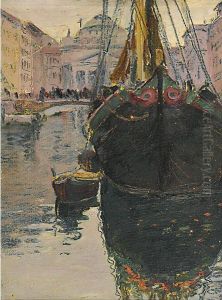Friedrich Capelari Paintings
Friedrich Capelari was an Austrian artist known for his unique style that blended elements of Art Nouveau with Orientalist themes. Born in 1884 in Austria, Capelari's artistic journey began in the early 20th century, a period marked by a fascination with the exotic and the emergence of new artistic movements that challenged traditional boundaries and conventions. His work is often characterized by a delicate interplay of forms and colors, drawing heavily on influences from Japanese art, which had a profound impact on European artists during this era.
Capelari's artistry was not confined to a single medium; he was proficient in a variety of techniques including painting, graphic design, and illustration. His illustrations, in particular, stood out for their intricate details and the subtle use of color, which captured the imagination of a wide audience. Capelari's contributions to graphic art were significant, as he was part of the movement that sought to elevate the status of graphic design to that of the fine arts. His works often featured themes of nature, mythology, and the exotic, blending Western and Eastern motifs in a manner that was both innovative and captivating.
Throughout his career, Friedrich Capelari remained somewhat of an enigmatic figure, never fully aligning himself with any single art movement but instead forging his own path. His works were exhibited in several European cities, garnering attention and acclaim for their originality and aesthetic appeal. Despite his talent and the unique quality of his work, Capelari is not as widely recognized today as some of his contemporaries. His death in 1950 marked the end of a career that, while not extensively documented, contributed significantly to the fields of graphic design and illustration, leaving behind a legacy that continues to inspire artists and designers exploring the intersection of Western and Eastern art forms.
